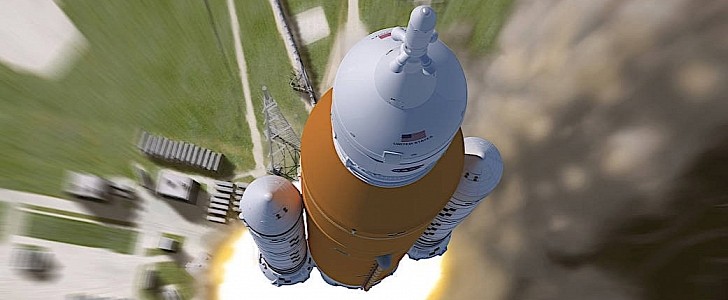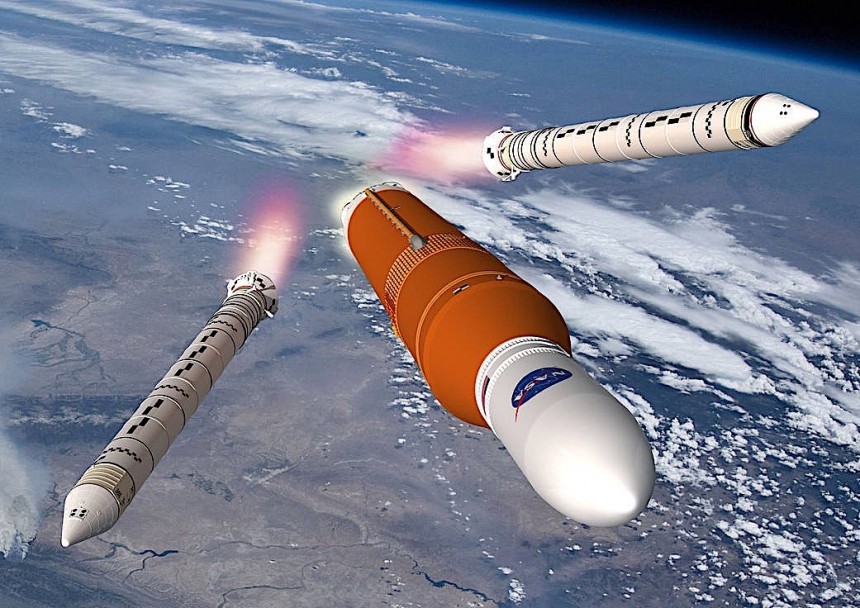If all the pieces of the gigantic puzzle fall into place, humanity will step into the age of the Artemis lunar program by the end of the year. It is then when the first in what is hoped to be a long line of Space Launch System rockets will take off, carrying on top an empty Orion capsule that will circle the Moon.
The Space Launch System, or SLS, has been in the making for some time now, but the engineers working on it have just begun seeing the light at the end of the tunnel. A few days ago, they started installing the flight software on the three computers that will help the rocket navigate its way up. At the same time, the stacking of the massive piece of engineering is slowly coming to an end.
Because of this, we thought this would be a great time to have a closer look at the thing that is meant to open the heavens for us, this time, hopefully, for good. And we’ll do so by having a quick glance at the hard-to-wrap-our-heads-around numbers that make up this incredible piece of engineering.
The SLS is described as a super-heavy-lift launch vehicle packing “unprecedented power and capabilities.” It is the only rocket that will be capable of pushing the Orion out of the grips of Earth’s gravity, and on to the Moon.
Artemis I, the trial mission which will take off later this year, will use the Block 1 configuration. That translates into a rocket 322 feet tall (98 meters) and weighing 5.75 million lbs (2.6 million kg, or 2,800 tons). This rocket will help Orion move 280,000 miles (450,000 km) away from Earth, on an orbit 40,000 miles (64,000 km) further out than the Moon.
For it to be able to do all this, the rocket needs some serious hardware. The core stage of the thing, made by Boeing, gets its power from four RS-25 engines fueled by 730,000 gallons (2.763 million liters) of super-cooled liquid hydrogen and liquid oxygen. They are made by Aerojet Rocketdyne and are not unlike the engines used on the space shuttle, reconfigured to suit the needs of the SLS with the addition, among other things, of a new engine controller and nozzle insulation.
Each engine should develop 512,000 lbs. of thrust for a total of over 2 million during takeoff. The engines of the core stage are backed in their mission by two solid rocket boosters, also sourced from the shuttle program, and modified by Northrop Grumman. With them, the total thrust of the SLS jumps to 8.8 million pounds (15 percent more thrust than the Saturn V rocket that supported the Apollo program), and that is expected to grow to 9.5 million lbs. of thrust once Block 2 of the SLS becomes operational a few years from now.
This mammoth piece of engineering was put together with a single goal in mind: to lift the Orion off the ground and place it into an orbit that would allow it to launch itself further out to the Moon. Even so, it can only lift and send to deep space 83,700 lbs (38 tons) of cargo, Orion capsule and crew included.
Getting the SLS to close-to-ready condition was not an easy task. Work on the rocket began in 2011, with the project’s cost reaching a mammoth $18.6 billion in 2020. And the spending does not end there. Each time an SLS rocket will launch something into space, the U.S. will need around $2 billion to cover the expenses.
But that’s not necessarily a bad thing, given how most of the money has been and will be spent in the U.S., as over 1,000 local companies, big or small, are involved in the project.
Because of this, we thought this would be a great time to have a closer look at the thing that is meant to open the heavens for us, this time, hopefully, for good. And we’ll do so by having a quick glance at the hard-to-wrap-our-heads-around numbers that make up this incredible piece of engineering.
The SLS is described as a super-heavy-lift launch vehicle packing “unprecedented power and capabilities.” It is the only rocket that will be capable of pushing the Orion out of the grips of Earth’s gravity, and on to the Moon.
For it to be able to do all this, the rocket needs some serious hardware. The core stage of the thing, made by Boeing, gets its power from four RS-25 engines fueled by 730,000 gallons (2.763 million liters) of super-cooled liquid hydrogen and liquid oxygen. They are made by Aerojet Rocketdyne and are not unlike the engines used on the space shuttle, reconfigured to suit the needs of the SLS with the addition, among other things, of a new engine controller and nozzle insulation.
Each engine should develop 512,000 lbs. of thrust for a total of over 2 million during takeoff. The engines of the core stage are backed in their mission by two solid rocket boosters, also sourced from the shuttle program, and modified by Northrop Grumman. With them, the total thrust of the SLS jumps to 8.8 million pounds (15 percent more thrust than the Saturn V rocket that supported the Apollo program), and that is expected to grow to 9.5 million lbs. of thrust once Block 2 of the SLS becomes operational a few years from now.
Getting the SLS to close-to-ready condition was not an easy task. Work on the rocket began in 2011, with the project’s cost reaching a mammoth $18.6 billion in 2020. And the spending does not end there. Each time an SLS rocket will launch something into space, the U.S. will need around $2 billion to cover the expenses.
But that’s not necessarily a bad thing, given how most of the money has been and will be spent in the U.S., as over 1,000 local companies, big or small, are involved in the project.



















